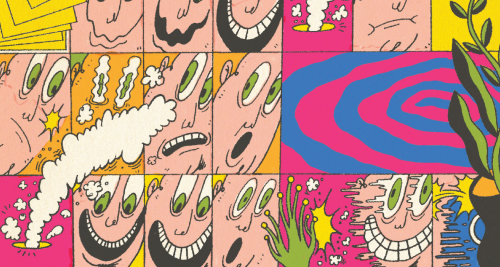Follow the Fox: Desa Kitsuné’s Visual Identity by Sciencewerk
Located in the ever-popular Canggu area, Desa Kitsuné is the first ever exclusive dayclub run by the Savaya Group in Bali. Described on their website as “a collective establishment”, the Desa, or village, was created together with the renowned French lifestyle brand Maison Kitsuné, housing one of their boutiques on site. In the months prior to Desa Kitsuné’s opening, Sciencewerk, a Surabaya-based design studio, was entrusted to create the visual identity of this dayclub.
The initial brief handed to the Sciencewerk team tasked them with designing not only the visual identity of the Kitsuné complex comprising the dayclub, a cafe, a restaurant, and a fashion boutique encompassed under the theme of “village”, inspired by the Indonesian desa lifestyle. “But all these elements will have a core theme of the fox, which is the primary identity of the global Kitsuné brand,” said Danis Sie, Founder and Design Director at Sciencewerk. “This design combines the natural element of Bali and a tropical beauty, as well as adopting Kitsuné’s signature “Art de Vivre” style, which emphasizes the art of living with elegance and a simple and modern beauty,” he continued.
The Sciencewerk team kicked off their design process, as always, by landing on a narrative not only for the base identity like the logo and supporting materials but also for the overall identity and experience. “We also explored many other elements like installation design as well as digital media. Here, we pictured the ambience of a village but with its own Kitsuné touch,” Danis elaborated. Beyond the visual identity of Desa Kitsuné, Sciencewerk was also entrusted with the identity design of Ina Ré, the restaurant and one of the core components of the Kitsuné complex. With this in mind, the Sciencewerk team decided on the narrative “Friends & Family”.

The “Friends & Family” narrative is a combination of the French philosophy of “Art de Vivre” and the Indonesian philosophy of “Gotong Royong”. “Gotong Royong”, meaning to work together or to help one another in the local context, is visualized through the fox totem to represent the spirit of friendship and family. This ‘Friendship’ Totem is designed to be the mascot of the “Friends & Family” narrative and is a core element of the overall Desa Kitsuné identity. “This identity is actualized in the form of this installation. It’s a statement that creates a surreal and artistic atmosphere for the visitors,” Denis elaborated.
Sciencewerk also constructed the “Follow the Fox” campaign narrative in their designs. “Follow the Fox” tells the tale of how the fox arrives at Dewata Island. “It’s delivered simply by showcasing the Kitsuné foxes on their journey until eventually settling at a village with all their friends…This campaign displays a brand narrative by placing the fox at several prominent locations in Bali, using CGI to create an interesting visual. The totem is placed in several recognizable areas of Bali. This campaign was specifically created for the pre-opening period as a press release teaser to emphasize the surrealism aspect, different from other more direct promotional campaigns,” Danis explained.
Executed by Habitat 8, the architecture of the space supports the desa theme with a design inspired by traditional villages. This layout places a core element in the center surrounded by several different spaces with an interior that reflects the village life and emphasizes local crafts at every point. “The use of warm toned and natural colors helps the architecture blend into the surrounding natural environment,” Danis noted. “Meanwhile, the Kitsuné chevron is subtly applied throughout the whole area, whether it be in the facade or in other architectural elements.”
A major part of the Desa Kitsuné complex is the Mediterranean fusion restaurant Ina Ré, the visual identity of which was also designed by the Sciencewerk team. Inspired by the Inari Ōkami, the Japanese Shinto god of rice, harvest, and prosperity. “The Inari are closely related to the Kitsuné (Japanese for fox) in Japanese folktales in their role as emissaries. Inari Temples often feature many small fox statues as temple guardians and Torii gates which mark the entrance to a sacred realm. All these elements are infused into the details of the restaurant design,” Danis elaborated. The Ina Ré logotype takes inspiration from the Torii gates and Jineng. The infusion of the Jineng,traditional Balinese granaries regarded as sacred, as a visual element also serves as a nod to the Inari Ōkami while also symbolizing the spirit of prosperity in traditional Balinese villages.
Simply looking at the scale of this project, it’s clear that executing such an identity did not come without its own set of challenges. Danis explained that the time constraints did pose a hurdle for the Sciencewerk team. As an extension of the Kitsuné brand, the use of the fox iconography was non-negotiable. As such, the Sciencewerk team had to find the best way to implement the fox icon into something even more unique and iconic. “Another challenge was dealing with the cultural differences, working directly with the internal Kitsuné team in Paris, who may have different views on design, terms, language as well as culture. Sometimes the local Indonesian elements we would try to bring to the table didn’t fit or were slightly unrelated,” Danis explained.
The overall visual identity designed by Sciencewerk proposes something refreshing while still maintaining the strong existing and iconic visual element of the fox. Desa Kitsuné as a modern and somewhat utopian and self-described “hedonistic” take on a local Balinese village brings something interesting to the table in an area that is becoming increasingly saturated with beach clubs by utilizing a beloved icon and blending the brand with a factor of surrealism through a strong narrative and an even stronger visual identity.


























